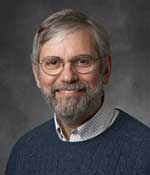Philip H. Bucksbaum
Vice President
Biographical Summary

Bucksbaum was born and raised in Iowa, and graduated from Harvard in 1975. He attended U.C. Berkeley on a National Science Foundation Graduate Fellowship and received his Ph.D. in 1980 for atomic parity violation experiments under Professor Eugene Commins, with whom he also has co-authored a textbook, "Weak Interactions of Leptons and Quarks." In 1981 he joined Bell Laboratories, where he pursued new applications of ultrafast coherent radiation from terahertz to vacuum ultraviolet, including time-resolved VUV ARPES, and strong-field laser-atom physics.
He joined the University of Michigan in 1990 and stayed for sixteen years, becoming Otto Laporte Collegiate Professor and then Peter Franken University Professor. He was founding Director of FOCUS, a National Science Foundation Physics Frontier Center, where he pioneered research using ultrafast lasers to control quantum systems. He also launched the first experiments in ultrafast x-ray science at the Advanced Photon Source at Argonne National Lab. In 2006 Bucksbaum moved to Stanford and SLAC, and organized the PULSE Institute to develop research utilizing the world’s first hard x-ray free-electron laser, LCLS. In addition to directing PULSE, he has previously served as Department Chair of Photon Science and Division Director for Chemical Science at SLAC. His current research is in laser-interrogation of atoms and molecules to explore and image structure and dynamics on the femtosecond scale. He currently has more than 250 publications.
Bucksbaum is a Fellow of the APS and the Optical Society, and has been elected to the National Academy of Sciences and the American Academy of Arts and Sciences. He has held Guggenheim and Miller Fellowships, and was Optical Society President in 2014. He has led or participated in many professional service activities, including NAS studies, national and international boards, initiatives, lectureships and editorships. Within the APS he has been active in DAMOP and DLS. He has served as a Laser Science Divisional Associate Editor for Physical Review Letters, he was a member of the Physical Review Letters Advisory Board, and he has served on the APS Executive Board.
Candidate Statement
The diversity of physics in the 21st century is breathtaking: Gravity waves, topological insulators, attosecond motion, Schwinger intensities, picokelvin temperatures, cosmic inflation, all show how our research is often defined by extremes, in space, time, complexity, and every other way. Yet the common values that bind physicists together are stronger today than ever. These include a firm belief in the value of scientific inquiry and the importance of progress in science, not only to enable tomorrow’s technologies but also as part of our nature as intelligent beings. These core values are acknowledged and shared by broader society as well. Advances in physics are very cool.
The most important service APS provides to this broad physics community is peer-reviewed archival publishing, but the landscape is changing rapidly through competition, the internet, and government mandates. The APS must find effective ways to carry out this vital function. The overwhelming majority of papers submitted to APS journals have non-U.S. authors, and much of the growth of the physics community in the coming decades will occur outside the U.S. As the world’s leading scholarly society for physics, the APS has been serving this expanding international community for years. We must continue to seek new and better ways to foster communication and contact throughout our worldwide community.
Recently there have been public accusations that scientists exaggerate and distort results to secure public funding for research or to satisfy political goals. Fundamental research is above partisan politics, and these are charges we cannot ignore. The APS has an organizing role to educate policy makers and the public about the nature of physics research, and to re-affirm the importance of shared investment in our students, our advanced instrumentation, and our research future. Physics benefits everyone.
Two optimistic continuing trends are the increased numbers and diversity of younger members of the physics community. More than two-fifths of the total APS membership are early career or student physicists. My experience in academic research has taught me the tremendous value of empowering youth, and I intend to find more ways to engage their energy and breadth of backgrounds and ideas to help guide the future of the Society.
When I first joined the APS in the early 1970s at the urging of one of my college physics professors, I found it was a family of scholars who shared my enthusiasm for physics. This community has helped me find and develop my own identity as a physicist over more than four decades. I am honored to have an opportunity to give something back to the members of the APS by serving as a candidate for the presidential leadership line.

